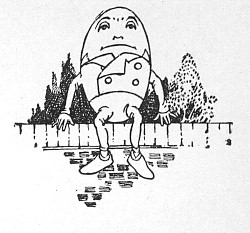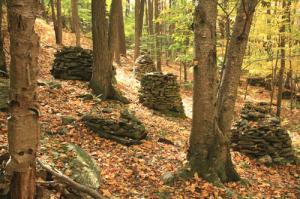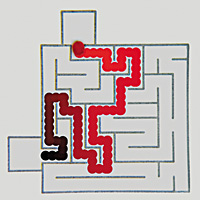I’ll keep this brief – check out this awesome gallery of science over at the New York Times (the pictures are some of the “winning photographs and illustrations from the 2009 International
Science and Engineering Visualization Challenge”).
Author: Richard
Why do we think Humpty Dumpty is an egg?

Image via Wikipedia
My girlfriend pointed out this interesting tidbit that was posted on Yahoo! today. We always visualize Humpty Dumpty as an egg, and yet nowhere in the rhyme itself is he described as such. Yahoo! Answers provides some insight:
Indeed the rhyme
Humpty Dumpty sat on a wall,
Humpty Dumpty had a great fall.
All the king’s horses and all the king’s men
Couldn’t put Humpty together again….does not tell us at all that
Humpty was an egg. However its etymology has a number of variations,
and it was in Lewis Carroll’s 1871 book “Through the Looking Glass”
(that used this rhyme), where the book’s illustrator John Tenniel first
drew Humpty as an egg, sitting on a wall.
An 1810 version of the rhyme also does not explicitly state that the
subject is an egg because it was originally posed as the riddle as such:
Humpty Dumpty sate on a wall,
Humpty Dumpty had a great fall;
Threescore men and threescore more,
Cannot place Humpty dumpty as he was before.
Furthermore, “humpty dumpty” was an eighteenth-century reduplicative
(linguistic root) slang for a short and clumsy person.
Pictured is Tenniel’s illustration from Through the Looking Glass. Fascinating stuff – it’s funny how this sort of thing happens.
Interestingly, the Wikipedia page on Humpty Dumpty goes on to detail speculation that Humpty Dumpty may have actually been “a cannon used in the siege of Gloucester in 1643 during the English Civil War” made of brittle metal and used by the Royalist faction. Another possible origin is King Richard III of England,
Shakespeare’s hunchbacked Egg, the ‘Wall’ being either the name of his horse
(called ‘White Surrey’ in Shakespeare’s play) or a reference to the
supporters who deserted him. During the battle of Bosworth Field, Richard
fell off his steed and was said to have been ‘hacked into pieces.’ (Though the play depicts Richard as a hunchback, other historical
sources suggest that he was not.)
Physicists “break the laws of nature.”
… Let’s hope Mother Nature didn’t have any traffic cops in the area. Yesterday, we mentioned that the Brookhaven National Laboratory had managed, under experimental conditions, to create temperatures of up to 4 trillion degrees Celsius. Apparently, in doing so they “briefly distorted the laws of physics”:
physicists have been accelerating gold nuclei around a 2.4-mile
underground ring to 99.995 percent of the speed of light and then
colliding them in an effort to melt protons and neutrons and free their
constituents — quarks and gluons. The goal has been a state of matter
called a quark-gluon plasma, which theorists believe existed when the
universe was only a microsecond old.The departure from normal
physics manifested itself in the apparent ability of the briefly freed
quarks to tell right from left. That breaks one of the fundamental laws
of nature, known as parity, which requires that the laws of physics
remain unchanged if we view nature in a mirror.
See more here!
Another short series of things worth looking at
Here’s another brief roundup. I promise that soon I’ll write some legitimate entries! For now, though, check out the following:
- The Introvert’s Corner – a blog about introversion. Tagline: “How to live a quiet life in a noisy world.”
- Exploded views of everyday objects – ever wondered about the inside of an Etch-a-sketch? Check it out. Among other things.
- Man creates vacuum-cleaner powered Spiderman device with which to climb walls
- (Unemployed) man (from my neighborhood) creates decked-out igloo with which to escape the harsh realities of the economy
- The interesting relationship between hallucinations and math (it’s not just the boredom that does it, apparently)
- Scientists at the Brookhaven National Laboratory, via high-speed collisions, cause a mixture to reach the temperature of 4 trillion degrees Celsius.
A short roundup of interesting things!
I’ve been swamped with work lately so I haven’t been on top of things, but here’s some fun, weird, and interesting stuff I’ve nonetheless come across (when I should have been doing the work I’m swamped with):
- Have scientists developed a treatment for autism? Apparently, an oxytocin hormone has been shown to increase social interaction. My question is, will “neurodiversity” advocates protest this? They argue that there’s nothing “wrong” with autism and Asperger’s patients, they’re just “different.” From their point of view, this might seem like an X-Men 3 type of situation.
- The marshmallow test: kids are guinea pigs in this test of self-control. Can they resist the marshmallow in front of them in the hopes of receiving an extra one after five minutes?
- New transistors mimic the human brain.
- Was the Alaska purchase (aka “Seward’s Folly) worth it? Maybe not. (And not just because of Sarah Palin.)
- A second brain in the gut
That’s all for now. Check back soon for more!
The mysterious stone cairns of Susquehanna County
Susquehanna County lies in the upper northeast corner of Pennsylvania. By most accounts, it is a fairly nondescript place – roughly rectangular in shape, fairly rural, a little poorer and more Republican than average, but nothing to write home about. Or nothing, at least, besides the mysterious stone cairns that stand, silently, in the forests of Susquehanna County. You won’t see these bizarre constructs mentioned in the county’s Wikipedia page or local government website. But they’re there.
A cairn, for those unfamiliar, is a manmade pile of stones. According to Wikipedia, they are typically conical, and may mark the summit of a mountain or a burial site (you can read about cairns in great detail here). In the northeastern United States, they oftentimes delimit the boundaries of an old field turned fallow (farmers, when clearing a field, would pile all the rocks alongside it). My friend’s grandparents have a wooded property in New York, for instance, and there is a rough series of cairn-like piles of stones bordering out what once was farmland. Those stones, though, were quite obviously at one point a wall. The Susquehanna stones aren’t so easily explained: they’re too haphazard to demarcate farmland, they don’t appear to be grave markers, and they certainly don’t indicate the summit of a mountain.
The Susquehanna stones, in fact, are apparently the most extensive site of its kind in  Pennsylvania. Theories abound as to their origin and purpose; some suggest they were erected by Native Americans, similar to the extensive burial mounds in Ohio. But there is no clear sign as to when they were originally built – Pennsylvania author Matt Lake writes that “no literary works, letters, or paintings from the colonial period mention odd rock piles in this part of the country … the oldest reference seems to date from an 1822 travelogue about a trip across New York State.” Princeton scholar Norman Muller, though, believes that the cairns were nonetheless erected well before then.
Pennsylvania. Theories abound as to their origin and purpose; some suggest they were erected by Native Americans, similar to the extensive burial mounds in Ohio. But there is no clear sign as to when they were originally built – Pennsylvania author Matt Lake writes that “no literary works, letters, or paintings from the colonial period mention odd rock piles in this part of the country … the oldest reference seems to date from an 1822 travelogue about a trip across New York State.” Princeton scholar Norman Muller, though, believes that the cairns were nonetheless erected well before then.
The stones themselves provide no answers, though. They simply stand silently in the forest, intriguing and confusing the few visitors who happen upon them.
Hit ’em with the Razzle Dazzle – ship camouflage in WWI
In line with our earlier mention of the WWII battleship 
that disguised itself as a tropical island, here’s a particularly interesting and informative article about ship camouflage during WWI. Apparently, those wacky zebra-stripe patterns weren’t just stylin’ decoration – the “bright, loud colors and contrasting diagonal stripes make it
incredibly difficult to gauge a ship’s size and direction.” Check out the article here.
Earthquakes in Illinois?
The United States Geological Survey is reporting that it has recorded a magnitude 3.8 earthquake in northern Illinois (see also the NY Times article). This is not unheard of; earthquakes do sometimes occur east of the Rockies (my own mother has told me of a medium-sized earthquake that was felt in Northeast Ohio a few decades ago). Nevertheless, northern Illinois is well outside of any geological hotspots (the US Geological Survey maps it in Seismic Zone 0, the zone of lowest risk). And this is especially troubling given – as we noted earlier – scientists’ fears that the Haiti quake forewarns increased seismic activity and the hundreds of small tremors that have been rocking Yellowstone National Park over the past few weeks.
Acidic droplet solves maze
From Chemical & Engineering News:
A team led by Northwestern University chemistry professor Bartosz A.
Grzybowski has shown that an acidic droplet can successfully
navigate a complex maze (J. Am. Chem. Soc., DOI: 10.1021/ja9076793).
“I personally find most exciting that such a simple system can
exhibit apparently ‘intelligent’ behavior,” Louisiana State University
chemistry professor John
A. Pojman comments. “This approach may be useful as a pumping
method for microfluidics or a way to convert chemical energy to
mechanical motion in small devices. I am eager to see if they can
generalize it to other types of gradients,” he says.
Drawing every person in New York
Jason Polan has embarked on an ambitious (almost comically so) project: he’s trying to draw every man, woman, and child in New York City. It sounds like something along the lines of the 2010 Census’s recent advertisements, but this is for real. In his own words, Jason is trying to
draw every person in New York. I will be drawing people everyday
and posting as frequently as I can. It is possible that I will draw you
without you knowing it. I draw in Subway stations and museums and
restaurants and on street corners. I try not to be in the way when I am
drawing or be too noticeable. Whenever I have a new batch of drawings I
will post them on this blog. If you would like to increase the chances
of a portrait of YOU appearing on this blog please email me (art@jasonpolan.com)
a street corner or other public place that you will be standing at for a
duration of two minutes (I will be on the corner of 14th street and 8th
avenue on the North-east corner of the street from 2:42-2:44pm this
Thursday wearing a bright yellow jacket and navy rubber boots, for
example). Please give me more than a 24 hour warning and please make it a
scenario that is not too difficult for you to accomplish (the corner
outside of the store you work at during lunch time, or in front of a
museum you were going to go to on a Saturday) because I may
unfortunately miss you and do not want you to have to invest more than 2
minutes of your time in case I cannot make it.
You can follow Jason’s progress at his website, here.
Some interesting tidbits
- Burials made easy: a screw-in coffin
- The lost lizard people of Los Angeles may be lost, but we at least know where they were
- Check out this Batman and Robin comic generator for endless fun
A more fragrant world?
According to leading climatologists and plant scientists, the Earth will become more fragrant as it grows warmer. Apparently, the higher temperatures will lead plants to produce more aromatic chemicals. From BBC Earth News:
Climate change will make the world more fragrant.
As
CO2 levels increase and the world warms, land use, precipitation and
the availability of water will also change.In response to all
these disruptions, plants will emit greater levels of fragrant chemicals
called biogenic volatile organic compounds.That will then alter
how plants interact with one another and defend themselves against
pests, according to a major scientific review.According
to the scientists leading the review, the world may already be becoming
more fragrant, as plants have already begun emitting more smelly
chemicals.“The increase is exponential,” says Professor Josep
Penuelas, of the Global Ecology Unit at the Autonomous University of
Barcelona, Spain.“It may have increased already by 10% in the
past 30 years and may increase 30 to 40% with the two to three degrees
(Celsius) warming projected for the next decades.”
![Reblog this post [with Zemanta]](http://img.zemanta.com/reblog_e.png?x-id=51fb1c72-b5ce-4a0c-922c-23848e730dcb)
